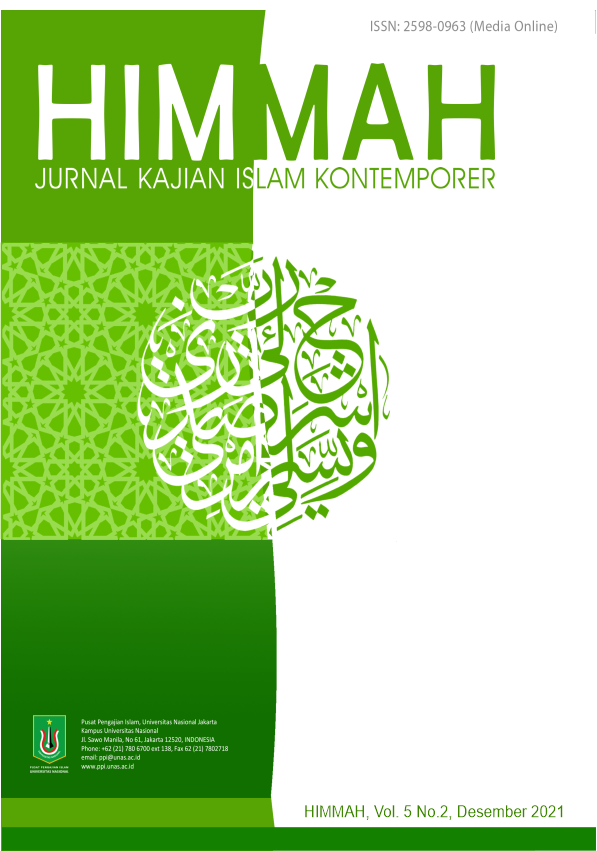Idealisasi Metode Living Qur’an
DOI:
https://doi.org/10.47313/jkik.v5i2.1510Abstract
Abstract
Living Qur’an is one of the contemporary method which needs some supports to be acquired as a scientific research in al-Qur’an. Actually this method refers to phenomenology which depends its research on social phenomenon. Along this process, the normative value of al-Qur’an should be maintained too in order to get the research result of Living Qur’an to be in line with the function of al-Qur’an itself. This research endorsed the Living Qur’an to be referred to the text of Al-Qur’an for avoiding its research to be contradictive with al-Qur’an. Living Qur’an placed the social symptoms as the research object, furthermore it can bring the understanding of Qur’an to be apart from its text. After having research, it can be valued whether the social phenomenon of implementing al-Qur’an is suitable with the text or not. If the result is in line with al-Qur’an so the research can be completed. Otherwise, the research should be continued by using Living Qur’an in order to perfect the implementation of al-Qur’an. This article also shared the way to idealize the method by combining Living Qur’an with the research of text related to the research object. It’s also recommended to combine the using Living Qur’an as method to recognize the social phenomenon of implementing al-Qur’an and Living Qur’an as the way to perfect the process of implementing al-Qur’an.
Keywords: living Qur’an, phenomenology, tafsir
Abstrak
Living Qur’an adalah salah satu metode penelitian kontemporer yang memerlukan penguatan agar semakin diakui keberadaannya sebagai salah satu proses kerja ilmiah dalam bidang Ilmu Al-Qur’an. Metode ini mengakar kepada fenomenologi yang menjadikan fenomena sosial sebagai objek penelitian. Seiring dengan pengembangannya yang semakin massif, nilai-nilai normatif dalam kajian tafsir perlu tetap dijaga agar hasil penelitiannya tetap sejalan dengan fungsi al-Qur’an sebagai pegangan hidup. Penelitian ini ingin membuktikan pentingnya Living Qur’an untuk tetap mengacu kepada teks al-Qur’an agar terhindar dari kemungkinan hasil penelitian yang berselisih dengan nilai-nilai al-Qur’an itu sendiri. Fenoemana sosial yang menjadi hasil dari kajian Living Qur’an dapat menggiring pemahaman al-Qur’an yang berbeda dengan teks al-Qur’an. Setelah ditemukan hasil penelitian Living Qur’an berupa fenomena implementasi al-Qur’an, maka hal itu dapat dijadikan sebagai dasar apakah hal tersebut sudah sejalan dengan nilai al-Qur’an atau masih dibutuhkan proses penyempurnaan agar lebih sesuai dengan al-Qur’an. Jika ada ketidaksesuaian maka proses proses penyempurnaan pengamalam nilai-nilai al-Qur’an dapat dijalankan secara simultan. Di sinilah letak proses idealisasi metode Living Qur’an. Penelitian ini merekomendasikan agar setiap kajian Living Qur’an disandingkan dengan kajian teks al-Qur’an yang berkaitan dengan tema penelitian. Langkah tersebut sekaligus memadukan antara metode Living Qur’an sebagai kajian terhadap fenomena implementasi al-Qur’an yang ada di tengah masyarakat dan Living Qur’an sebagai upaya menghidupkan al-Qur’an dalam kehidupan sosial.
Kata kunci: living Qur’an, fenomenologi, tafsir
References
Akmaludin, M. (2017). Diskursus Penelitian Al-Qur’an dan Hadis dengan Ilmu Pengetahuan Modern. Prosiding Seminar Nasional dan Internasional . Universiti Malaysia Sabah.
Blumenau, R. (2001). Kant and the Thing in Itself. Diambil kembali dari Philosophy Now: https://philosophynow.org/issues/31/Kant_and_the_Thing_in_Itself
Esack, F. (2007). The Qur’an: A User’s Guide. Oxford: Oneworld Publication.
Farhan, A. (2017). Living Al-Qur’an Sebagai Metode Alternatif dalam Studi Al-Qur’an. El-Afkar, 6(2), 91.
Fitriana, M. A., & Choirunnisa, A. (2018). Studi Living Qur’an di Kalangan Narapidana. Misykat, 3(2).
Hallaq, W. B. (2005). The Origins and Evolution of Islamic Law. Cambridge: Cambridge University Press.
Hasbillah, A. U. (2021). Ilmu Living Qur’an-Hadis. Darus Sunnah, 29.
Husserl, E. (1962). Ideas: General Introduction to Pure Phenomenology. New York: Macmillan.
Manoussakis, J. P. (2017). The Place of Das Ding: Psychoanalysis, Phenomenology, and Religion. Diambil kembali dari Religious Theory: http://jcrt.org/religioustheory/2017/02/21/the-place-of-das-ding-psychoanalysis-phenomenology-religion-part-2-john-panteleimon-man
Mubasyaroh. (2014). Da’wah Model of Prophet Muhammad in Madina. QIJIS, 2(1), 48-49.
Mustaqim, A. (2015). Metode Penelitian Al-Qur’an dan Tafsir. Yogyakarta: Idea Press.
Noh, M. A., & Huda, M. (2020). Understanding the Quran Resources. Journal of Critical Reviews, 7(2), 688.
Putra, A., & Yasir, M. (2018). Kajian Al-Qur’an di Indonesia. Tajdid, 21(17), 17.
Sugiyono. (2014). Metode Penelitian Kombinasi. Bandung: Alfabeta.
Downloads
Published
Issue
Section
License
Authors who publish with this journal agree to the following terms:
- Authors retain copyright and grant the journal right of first publication with the work simultaneously licensed under a Creative Commons Attribution License (CC BY-NC-SA 4.0) that allows others to share the work with an acknowledgment of the work's authorship and initial publication in this journal.
- Authors are able to enter into separate, additional contractual arrangements for the non-exclusive distribution of the journal's published version of the work (e.g., post it to an institutional repository or publish it in a book), with an acknowledgment of its initial publication in this journal.
- Authors are permitted and encouraged to post their work online (e.g., in institutional repositories or on their website) prior to and during the submission process, as it can lead to productive exchanges, as well as earlier and greater citation of published work (See The Effect of Open Access).


